
On Deadly Ground is a 1994 American environmental action adventure film directed, co-produced by, and starring Steven Seagal, and co-starring Michael Caine, Joan Chen, John C. McGinley and R. Lee Ermey. As of 2024, it is Seagal's only directorial effort and features a minor appearance by Billy Bob Thornton in one of his early roles. Seagal plays Forrest Taft, an expert firefighter who chooses to fight back against the environmental destruction caused by his ruthless former employer (Caine). On Deadly Ground was theatrically released in the United States on February 18, 1994, by Warner Bros. It garnered negative reviews from critics and grossed $78.1 million worldwide on a $50 million production budget.

Under Siege 2: Dark Territory is a 1995 American action thriller film directed by Geoff Murphy, starring Steven Seagal as the ex-Navy SEAL, Casey Ryback. Set on board a train traveling through the Rocky Mountains from Denver to Los Angeles, it is the sequel to the 1992 film Under Siege also starring Seagal. The title refers to the railroading term that the subject train was travelling through dark territory, a section of railroad track that has no train signals and in which communications between train dispatchers and the railroad engineers were impossible.

The Thin Red Line is a 1998 American epic war film written and directed by Terrence Malick. It is the second screen adaptation of the 1962 novel of the same name by James Jones, following the 1964 film. Telling a fictionalized version of the Battle of Mount Austen, which was part of the Guadalcanal Campaign in the Pacific Theater of the Second World War, it portrays U.S. soldiers of C Company, 1st Battalion, 27th Infantry Regiment, 25th Infantry Division, played by Sean Penn, Jim Caviezel, Nick Nolte, Elias Koteas, and Ben Chaplin. The novel's title alludes to a line from Rudyard Kipling's poem "Tommy", from Barrack-Room Ballads, in which he calls British foot soldiers "the thin red line of heroes", referring to the stand of the 93rd Regiment in the Battle of Balaclava of the Crimean War.

Eugene Kal Siskel was an American film critic and journalist for the Chicago Tribune. He is best known for co-hosting various movie review television series with colleague Roger Ebert.

Dante's Peak is a 1997 American disaster film directed by Roger Donaldson, written by Leslie Bohem, and starring Pierce Brosnan, Linda Hamilton, and Charles Hallahan. The film is set in the fictional town of Dante's Peak where the inhabitants fight to survive a volcanic eruption from a long dormant stratovolcano that has suddenly woken up. The film was released on February 7, 1997, under the production of Universal Pictures and Pacific Western Productions. It received negative reviews from critics but was an average success financially. It was the last film in which Charles Hallahan starred before his death nine months later in November 1997.
Broken Arrow or Broken Arrows may refer to:

Face/Off is a 1997 American science-fiction action thriller film directed by John Woo, from a screenplay by Mike Werb and Michael Colleary. It stars John Travolta and Nicolas Cage as an FBI agent and a terrorist, respectively, who undergo an experimental surgery to swap their faces and, in the process, their identities.

The Peacemaker is a 1997 American political action thriller film starring George Clooney, Nicole Kidman, Armin Mueller-Stahl, Marcel Iureș and Aleksandr Baluev and directed by Mimi Leder. It is the first film by DreamWorks Pictures. While the story takes place all over the world, it was shot primarily in Slovakia with some sequences filmed in New York City and Philadelphia.

At the Movies is an American movie review television program produced by Disney–ABC Domestic Television in which two film critics share their opinions of newly released films. Its original hosts were Roger Ebert and Gene Siskel, the former hosts of Sneak Previews on PBS (1975–1982) and a similarly titled syndicated series (1982–1986). Following Siskel's death in 1999, Ebert worked with various guest critics until choosing Chicago Sun-Times colleague Richard Roeper as his regular partner in 2000.

Muppet Treasure Island is a 1996 American musical swashbuckler comedy film directed by Brian Henson and the fifth theatrical film featuring the Muppets. Adapted from the 1883 novel Treasure Island by Robert Louis Stevenson, similarly to its predecessor The Muppet Christmas Carol (1992), the key roles were played by live-action actors, with the Muppets in supporting roles. The film stars Muppet performers Dave Goelz, Steve Whitmire, Jerry Nelson, Kevin Clash, Bill Barretta, and Frank Oz in various roles, as well as Tim Curry as Long John Silver and introduces Kevin Bishop as Jim Hawkins.

Invasion U.S.A. is a 1985 American action film produced by Cannon Films, and starring Chuck Norris. It was directed by Joseph Zito. It involves the star fighting off a force of Soviet/Cuban-led guerrillas.

The Gauntlet is a 1977 American action thriller film directed by Clint Eastwood, who stars alongside Sondra Locke. The film's supporting cast includes Pat Hingle, William Prince, Bill McKinney, and Mara Corday. Eastwood plays a down-and-out cop who falls in love with a prostitute (Locke), to whom he is assigned to escort from Las Vegas to Phoenix for her to testify against the mob.

The Swarm is a 1978 American natural horror film directed and produced by Irwin Allen and based on Arthur Herzog's 1974 novel. It stars an ensemble cast, including Michael Caine, Katharine Ross, Richard Widmark, Richard Chamberlain, Olivia de Havilland, Ben Johnson, Lee Grant, José Ferrer, Patty Duke, Slim Pickens, Bradford Dillman, Henry Fonda and Fred MacMurray in his final film role. It follows a scientist and a military task force who try to prevent a large swarm of killer bees from invading Texas. The film received overwhelmingly negative reviews from critics and was a box-office bomb, although praise was given to the costume design. It has been considered to be one of the worst films ever made.

Fire Birds is a 1990 American military action film directed by David Green and produced by William Badalato, Keith Barish and Arnold Kopelson. The storyline was conceived by retired Lt. Colonels Step Tyner and John K. Swensson and retired Marine Capt. Dale Dye and developed into a screenplay written by Paul F. Edwards, Nick Thiel and uncredited David Taylor. The film stars Nicolas Cage, Tommy Lee Jones and Sean Young. Cage is cast as a helicopter pilot attempting to help dismantle a drug cartel in South America. Jones plays his pilot instructor and senior ranked military officer during his flight training, while Young portrays his love interest.

Boxcar Bertha is a 1972 American romantic crime drama film directed by Martin Scorsese and produced by Roger Corman, from a screenplay by Joyce H. Corrington and John William Corrington. Made on a low budget, the film is a loose adaptation of Sister of the Road, a pseudo-autobiographical account of the fictional character Bertha Thompson. It was Scorsese's second feature film.

George of the Jungle is a 1997 American comedy film directed by Sam Weisman and based on Jay Ward and Bill Scott's 1967 American animated television series of the same name, which in turn is a spoof of the fictional character Tarzan, created by Edgar Rice Burroughs. Written by Dana Olsen and Audrey Wells, and starring Brendan Fraser, Leslie Mann, Thomas Haden Church, Holland Taylor, Richard Roundtree, and John Cleese. It tells the story of a young man raised by wild animals who falls for an heiress and contends with the heiress's spoiled fiancé. The film was produced by Walt Disney Pictures and was released in theatres throughout the United States and Canada on July 16, 1997. It was later aired on Disney Channel in the United States on December 5, 1998. The film received mixed reviews and grossed $174 million worldwide. A sequel, George of the Jungle 2, was released direct-to-video on October 21, 2003.

Loose Cannons is a 1990 American action comedy film written by Richard Matheson, Richard Christian Matheson and Bob Clark, who also directed the film. The film stars Gene Hackman as a hard-nosed cop who is teamed up with a detective with multiple-personality disorder, played by Dan Aykroyd, to uncover a long-lost Nazi sex tape, featuring Adolf Hitler, which would jeopardize the political future of the German chancellor-elect. The theme song features vocals by Katey Sagal and Aykroyd.

Mad City is a 1997 American thriller drama film directed by Costa-Gavras, written by Tom Matthews based on a story by Matthews and Eric Williams, and starring Dustin Hoffman and John Travolta, with a supporting cast featuring Mia Kirshner, Alan Alda, Blythe Danner, Ted Levine, Raymond J. Barry and Larry King. This is Costa-Gavras's first English-language film since Music Box. The title comes from a nickname of Madison, Wisconsin, where it originally was going to be set, and was used for its multiple meanings.

Diamond Skulls is a British 1989 thriller directed by Nick Broomfield who also co-wrote with Tim Rose-Price. An established documentary filmmaker, this is Broomfield's first work of fiction. It is produced by Tim Bevan and Jane Fraser and stars Amanda Donohoe, Gabriel Byrne and Struan Rodger and has a music score by Hans Zimmer. It includes the last film performance of Ian Carmichael.

Big Game is a 2014 action-adventure film directed by Jalmari Helander and written by Helander and Petri Jokiranta. It stars Samuel L. Jackson, Onni Tommila, Ray Stevenson, Victor Garber, Mehmet Kurtulus, Ted Levine, Felicity Huffman, and Jim Broadbent. The film follows a 13-year-old boy named Oskari (Tommila) in his efforts to protect the President of the United States William Alan Moore (Jackson) from terrorists who shot down Air Force One. Big Game is one of the most expensive Finnish films.



















